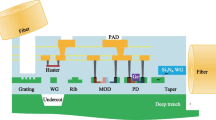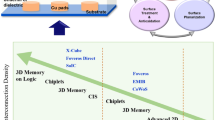Abstract
Recent advances in integrated circuit technology have imposed new requirements on the chip physical design process. At the same time that performance requirements are increasing, the effects of wiring on delay are becoming more significant. Larger chips are also increasing the chip wiring demand, and the ability to efficiently process these large chips in reasonable time and space requires new capabilities from the physical design tools. Circuit placement is done using algorithms which have been used within IBM for many years, with enhancements as required to support additional technologies and larger data volumes. To meet timing requirements, placement may be run iteratively using successively refined timing-derived constraints. Chip optimization tools are used to physically optimize the clock trees and scan connections, both to improve clock skew and to improve wirability. These tools interchange sinks of equivalent nets, move and create parallel copies of clock buffers, add load circuits to balance clock net loads, and generate balanced clock tree routes. Routing is done using a grid-based, technology-independent router that has been used over the years to wire chips. There are numerous user controls for specifying router behavior in particular areas and on particular interconnection levels, as well as adjacency restrictions.
Similar content being viewed by others
References
J.Y. Sayah, R. Gupta, D. Sherlekar, P.S. Honsinger, S.W. Bollinger, H.-H. Chen, S. DasGupta, E.P. Hsieh, E.J. Hughes, A.D. Huber, Z.M. Kurzum, V.B. Rao, T. Tabtieng, V. Valijan, D.Y. Yang, and J. Apte, “Design planning for high-performance ASICs,” IBM J. Res. Develop., Vol. 40, No. 3, pp. 431-452.
R.S. Belanger, D.P. Conrady, P.S. Honsinger, T.J. Lavery, S.J. Rothman, E.C. Schanzenbach, D. Sitaram, C.R. Selinger, R.E. DuBios, G.W. Mahoney, and G.F. Miceli, “Enhanced chip/package design for the IBM ES/9000,” Proceedings of the IEEE International Conference on Computer Design, pp. 544- 549, 1991.
J.H. Panner, R.P. Abato, R.W. Bassett, K.M. Carrig, P.S. Gillis, D.J. Hathaway, and T.W. Sehr, “A comprehensive CAD system for high-performance 300K-circuit ASIC logic chips,” IEEE J. Solid-State Circuits, Vol. 26, No. 3, pp. 300-309, March 1991.
R.F. Lembach, J.F. Borkenhagen, J.R. Elliot, and R.A. Schmidt, ”VLSI design automation for the application system/400,” Proceedings of the IEEE International Conference on Computer Design, pp. 444-447, 1991.
S. Kirkpatrick, C.D. Gelatt, and M.P. Vecchi, “Optimization by simulated annealing,” Science, Vol. 220, No. 4598, pp. 671-680, May 1983.
K.J. Antreich, F.M. Johannes, and F.H. Kirsch, “A new approach for solving the placement problem using force models,” Proceedings of the IEEE Symposium on Circuits and Systems, pp. 481-486, 1982.
R.-S. Tsay, E.S. Kuh, and C.-P. Hsu, “PROUD: A fast sea-ofgates placement algorithm,” Proceedings of the 25th ACM/IEEE Design Automation Conference, pp. 318-323, 1988.
K. Narayan, “Clock system design for high speed integrated circuits,” IEEE/ERA Wescon/92 Conference Record, pp. 21-24, 1992.
H.B. Bakoglu, J.T. Walker, and J.D. Meindl, “A symmetric clock distribution tree and optimized high speed interconnections for reduced clock skew in ULSI and WSI circuits,” Proceedings of the IEEE International Conference on Computer Design, pp. 118-122, 1986.
K.M. Carrig, D.J. Hathaway, K.W. Lallier, J.H. Panner, and T.W. Sehr, “Method and apparatus for making a skew-controlled signal distribution network,” U.S. Patent 5,339,253, 1994.
R.-S. Tsay, “An exact zero-skew clock routing algorithm,” IEEE Trans. Computer-Aided Design, Vol. 14, No. 12, pp. 242-249, Feb. 1993.
K.D. Boese and A.B. Kahng, “Zero-skew clock routing trees with minimum wirelength,” Proceedings of the Fifth Annual IEEE International ASIC Conference and Exhibit, pp. 17-21, 1992.
S. Pullela, N. Menezes, J. Omar, and L.T. Pillage, “Skewand delay optimization for reliable buffered clock trees,” Proceedings of the IEEE/ACM International Conference on Computer-Aided Design, pp. 556-562, 1993.
R. Kent Dybvig, The Scheme Programming Language, Prentice-Hall, Inc., Englewood Cliffs, NJ, 1987.
C.W. Koburger III, W.F. Clark, J.W. Adkisson, E. Adler, P.E. Bakeman, A.S. Bergendahl, A.B. Botula, W. Chang, B. Davari, J.H. Givens, H.H. Hansen, S.J. Holmes, D.V. Horak, C.H. Lam, J.B. Lasky, S.E. Luce, R.W. Mann, G.L. Miles, J.S. Nakos, E.J. Nowak, G. Shahidi, Y. Taur, F.R. hite, and M.R. Wordeman, “A half-micron CMOS logic generation,” IBM J. Res. Develop. Vol. 39, Nos. 1/2, pp. 215-227, Jan./March 1995.
P.C. Elmendorf, “KWIRE: A multiple-technology, userreconfigurable wiring tool for VLSI,” IBM J. Res. Develop., Vol. 28, No. 5, pp. 603-612, Sept. 1984.
Author information
Authors and Affiliations
Rights and permissions
About this article
Cite this article
Hathaway, D., Habra, R., Schanzenbach, E. et al. Circuit Placement, Chip Optimization, and Wire Routing for IBM IC Technology. The Journal of VLSI Signal Processing-Systems for Signal, Image, and Video Technology 16, 191–198 (1997). https://doi.org/10.1023/A:1007943124807
Published:
Issue Date:
DOI: https://doi.org/10.1023/A:1007943124807




